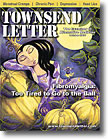


From the
Townsend Letter |
||
Recent Progress in Clinical Applications |
||
Continued. . . 1, 2, 3, 4, 5, 6, 7, 8, 9, 10, 11, 12
CLINICAL OUTCOME STUDY FOR FIBROMYALGIA Introduction The limited objective of this open, prospective clinical outcome study is to evaluate changes in the level of pain in fibromyalgia patients, utilizing a broad-spectrum antimicrobial protocol against virus, mycoplasma, fungi, and bacteria. Over a period of two years, forty-two FMS patients were treated utilizing this protocol. The patients were treated at three different locations: (1) the Ingles Integrative Medical Center, Tijuana, BC, Mexico, Prof. R W Bradford et al.; (2) Little Rock, Arkansas, N Becquet, MD; and (3) Washington, DC, Prof. Ann Marie Dixon et al. There were 41 female patients and one male patient, with ages ranging from 33 years to 68 years. All patients had the primary symptoms of acute muscle pain in shoulders and upper arms, with various secondary symptoms including cardiac irregularity, fatigue, depression, constipation, and swollen extremities. All the patients came in using various forms of pain medication. The duration of their FMS varied from six months to five years. The duration of clinical management was from one to six months. Assessments Therapy
Chart 8: Pre-Therapy
Considerations
Adverse Reactions Response Repeat procedure may be necessary within 30 days. Focal point infections in the bowel are often found, in which case, Sporenox (Itraconazole) at a dosage of 100 mg per day for 20 days has been beneficial. Probiotics to maintain bowel flora integrity should also be considered.
Chart 9: Post-Therapy Considerations for FMS – 90 Days 1. Diflukin, oral 2 weeks
|
||
![]()
Consult your doctor before using any of the treatments found within this site.
![]()
Subscriptions are available for Townsend Letter, the Examiner of Alternative Medicine magazine, which is published 10 times each year.
Search our pre-2001
archives for further information. Older issues of the printed magazine
are also indexed for your convenience.
1983-2001
indices ; recent indices
Once you find the magazines you'd like to order, please use our convenient form, e-mail subscriptions@townsendletter.com, or call 360.385.6021 (PST).

All rights reserved.
Web site by Sandy Hershelman Designs
